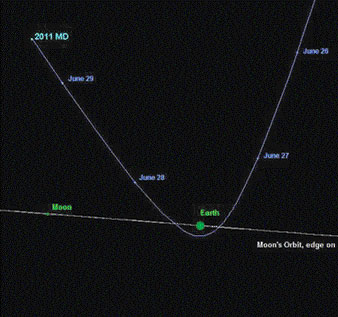|

Near-Earth asteroid
passes over Atlantic Ocean
 An
asteroid with an estimated girth as large as a garbage truck soared
within 7,500 miles of the Earth on Monday, June 30, as it passed
harmlessly over the Atlantic Ocean, according to NASA's Jet Propulsion
Laboratory (JPL). An
asteroid with an estimated girth as large as a garbage truck soared
within 7,500 miles of the Earth on Monday, June 30, as it passed
harmlessly over the Atlantic Ocean, according to NASA's Jet Propulsion
Laboratory (JPL).
The space rock, measuring 5 to 20 metres in diameter, followed the
same near-Earth path that scientists had earlier predicted, looping
around the planet in a boomerang-shaped trajectory, JPL spokesman D.C.
Agle said.
Its nearest approach to Earth, about 7,500 miles, was 30 times
farther away than the International Space Station, which orbits the
planet at a distance of 250 miles.On a more celestial scale, the
asteroid's closest distance to Earth was just 3 per cent of the 250,000
miles separating the Earth from the moon.
An object about the same size as Monday's near-Earth asteroid,
designated by scientists as 2011 MD, zips past the planet at about the
same distance every six years, according to JPL.Even if an asteroid the
size of 2011 MD ever entered the Earth's atmosphere, it would likely
burn up and cause no damage to the planet, JPL said.
-Science Daily
A
super-elastic alloy which may resist quakes
Researchers in Japan have developed a super-elastic alloy, which can
spring back to its original form in extreme temperatures, they said in a
report recently, adding that they hope it may be used in buildings to
absorb shocks from earthquakes.
The experts, who wrote about their invention in the journal Science,
added a small amount of nickel to an iron-based alloy, and found that
the new material can recover its original shape at any temperature from
-196 to 240 degrees Celsius.
Lead author Toshihiro Omori at the Department of Materials Science,
Graduate School of Engineering in Tohoku University, said this new
material was far more elastic than other super-elastic alloys, which
cannot revert to their original form outside the -20 to 80 degrees
Celsius range.
"Our ferrous alloy has temperature insensitivity by one order of
magnitude. This property is very important because materials are subject
to change in temperature in most cases," Omori wrote in an email in
response to questions from Reuters."Another advantage is its low cost.
The raw material is cheap ... resulting in the potential for large scale
applications," Omori wrote.The material may be used in environments that
are constantly exposed to extreme temperatures, such as joints and
controls in cars, planes and spacecraft, Omori and his colleagues
said.It may also help buildings cushion stress and violent movement in
earthquakes, the materials science experts added.
-Reuters |

